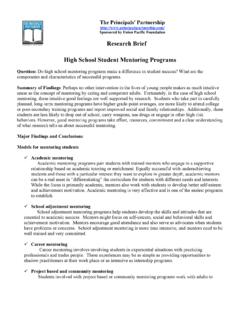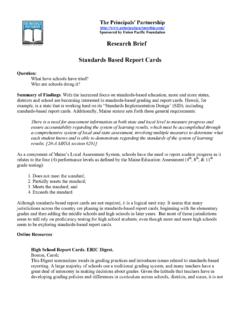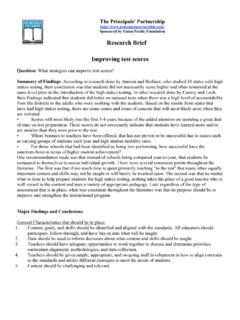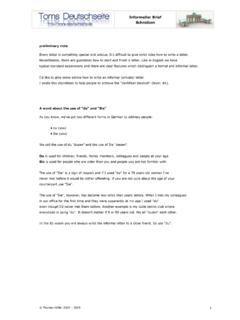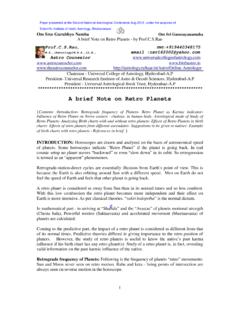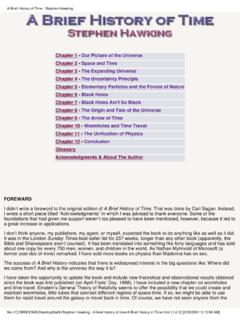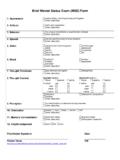Transcription of Research Brief High School Schedules - oemanagement.com
1 The Principals' by Union Pacific Foundation Research BriefHigh School SchedulesQuestion: How do common high School Schedules compare?Summary of Findings: Findings are mixed on the effectiveness of various scheduling models. Thesemodels include a traditional 7 or 8 period day, a block schedule with four classes meeting one day andanother four meeting the next (A/B Block), a block schedule of four classes that meet every day for a term(4x4 Block), and several hybrid models. Some findings conclude most schools are happy with their transitionto longer class periods, others that achievement and student attitude are improved, and others that the blockschedule proved disastrous over traditional scheduling. (Anecdotally, my son, who is bright, but strugglesacademically, performs much better in a 4x4 block where he only has to concentrate on four classes insteadof eight.)These mixed findings may say less about the effectiveness of block scheduling than they do about what questions the researchersasked and how the changes in scheduling were implemented.
2 There are numerous reports of teachers simply lecturing for 80minutes or still presenting for 40 and giving the remaining time to students to do homework, resulting in half the course materialbeing covered compared to traditional scheduling. It is not surprising in such cases that achievement can be reduced and studentand teacher attitudes decline. As Kathleen Cushman of the Essential Schools Project states, Moving to longer schedule blockscan help schools focus more on depth in the curriculum and active student engagement. But unless teachers get substantial time todevelop and reflect on new practices-and unless the needs of students drive the use of time - a long-block schedule won'taccomplish much. Much has been written on lessons learned from Block Scheduling, mistakes schools have made, and stepsschools might take to avoid those mistakes. The Center for Innovative School Scheduling and the Center forApplied Research and Educational Improvement are sources for that Resources:Using Time Well: Schedules in Essential SchoolsKathleen CushmanHorace.
3 Volume 12, #2. Nov. to longer schedule blocks can help schools focus more on depth in the curriculum and activestudent engagement. But unless teachers get substantial time to develop and reflect on new practices-and unless the needs of students drive the use of time-a long-block schedule won't accomplish Briefing: Block Scheduling in Secondary SchoolsBarbara DoughertyThis paper describes different models of block scheduling, offers benefits and disadvantages of themodels, and presents suggestions for schools considering block Principals' by Union Pacific Foundation Research BriefCenter for Innovative School SchedulingWelcome to the Center for Innovative School Scheduling (CISS) at the University of Virginia's CurrySchool of Education. The primary purpose of this Center is to provide interested individuals with thelatest and best information on innovative practices in School scheduling.
4 In addition, it provides userswith some of the latest Research on the subject and links them to practitioners and researchers who areleading the way in innovative Scheduling: What We've Center for Applied Research and Educational Improvement (CAREI)Block and & Scheduling: An IntroductionBy Michael Rettig and Judith Scheduling s Missteps, Successes and VariablesMichael D. Rettig and Robert Lynn CanadyThe School Administrator Web Edition; October 2003A study finds steady progress in the use of alternatives to the traditional schedule . While a few schoolshave returned to single periods, the vast majority of schools that adopted alternative scheduling modelscontinue to be satisfied with their decisions. We have documented one state s history of adoption,implementation and minimal reversion from block scheduling; highlighted mistakes some schools havemade; reviewed how alternative Schedules have been used as part of schools efforts to improve schoolenvironment and achievement; and looked at three variables related to School scheduling that affectstudent Scheduling (or Alternative or Flexible ) Principals' by Union Pacific Foundation Research BriefBlock Scheduling in the high School SettingA Synthesis of Evidence-Based ResearchChance W.
5 Lewis, Marc A. Winokur, R. Brian Cobb, Gail S. Gliner, & Joel SchmidtThe purpose of this study was to produce a systematic review and synthesis of evidence-based researchon the effect of block scheduling on student achievement in United States high schools. This reportprovides a Brief introduction to block scheduling, chronicles the search strategies used to locate thefinal literature set, and describes the processes employed to code the studies on outcome, intervention,and methodological criteria using the What Works Clearinghouse (WWC) framework. In addition,findings, conclusions, and recommendations are discussed for the studies that merited inclusion intothe block scheduling evidence :H1xB-Y- +%224x4%22+%22A/B%22+traditional+%22high + School %22+&hl=enBlock and traditional Schedules : Effects on students with and without disabilities in high schoolby Bottge, Brian J, Gugerty, John J, Serlin, Ron, Moon, Kyoung-SukNational Association of Secondary School Principals.
6 NASSP Bulletin, Sep 2003 The purpose of this study was to compare the effects of traditional and block Schedules on theacademic achievement of high School students with and without disabilities. Achievement data werecollected from the cumulative records and Individual Education Plans of 160 students with disabilitiesand the cumulative records of 460 students without disabilities. Achievement was measured bystudents' GPA; state-mandated tests in reading, language, math, science, and social studies; and collegeentrance ACT. Results showed no difference on all comparisons between students with disabilitiesattending block-scheduled high schools and students with disabilities attending traditional-scheduledhigh schools. Similar results were found for students without disabilities. Teachers on both schedulesreported high levels of satisfaction and comparable amounts of time on instructional BibliographiesBlock SchedulingResearch & Resources - Resources by SubjectAnnotated bibliography by subject Research : Studies showing advantages with block schedulingAnnotated Scheduling IssuesAnnotated Principals' by Union Pacific Foundation Research BriefConcerns Regarding Block SchedulingAn AskERIC ResponseJune 2003 Resources(Note: ERIC documents can be found by going to and entering the ERIC ID#)Secondary School Scheduling Models: How Do Types of Models Compare to the ACT Scores?
7 Hackmann, Donald G.; Hecht, Janet E.; Harmston, Matt T.; Pliska, Ann-Maureen; Ziomek, RobertL.; This study examined the relationship between School scheduling format and average compositescores on the ACT Assessment after controlling for lifestyle factors, gender, School enrollment levels,number of examinees, and years under the scheduling model. The participants were 38,089 highschools seniors in 568 public high schools in Iowa and Illinois who completed the ACT Assessmentin 1999. The focus was on data at the School level, and individual schools were represented by meanACT composite scores for the School . The three scheduling models considered were: (1) traditionaleight period (351 schools); (2) eight block alternating day (161 schools); and (3) 4x4 semester (56schools). In general, findings show that the scheduling type used at a School does not predict the ACTcomposite scores when examined at the School level. Some of the limitations of the study #: ED452230 The Effects of Block , Michael D.
8 ; Canady, Robert Lynn; School Administrator, v56 n3 p14-16,18-20 Mar 1999 Research reveals important generalizations about block scheduling. A/B Schedules are easier toimplement than 4/4 Schedules , which must be adapted to allow some year-long courses. Merelychanging the School bell schedule will not guarantee better student performance. However, blockscheduling typically improves climate, attendance, and #: EJ585529 The Block Scheduling , J. Allen; Block scheduling encourages increased comprehensive immersion into subject matter, improvedteacher-student relationships, and decreased disciplinary problems. While block scheduling may offerThe Principals' by Union Pacific Foundation Research Briefmany advantages, moving to a block schedule from conventional scheduling can be a majoradjustment for both students and teachers. This guide is intended to ease the problems of change bycombining a theoretical background with specific practical and proven tips and tools forimplementing a block schedule .
9 It discusses block scheduling in elementary, middle, and highschools, and includes an indepth case study of an exemplary elementary- School curriculum. Itexplains in detail the three block models-the 4x4 block schedule , the A/B block schedule , and themodified block-and how to select the best model. It offers guidance on curriculum alignment, pacing,and assessment models. It outlines effective instructional strategies for block scheduling, includingclassroom management and student-centered strategies. And it provides sample models, lessons,activities, forms, evaluations, and surveys for easy #: ED469437 Block Scheduling: Students' Perceptions of Readiness for College Math, Science, and , Mary; Lare, Douglas; Gnall, John; Adams, Don; American Secondary Education, v27 n4 p13-21 Sum 1999To garner student perceptions, a questionnaire listing questions for math, science, and foreignlanguage was sent to the 1997, 1996, and 1995 graduates of two Pennsylvania high schools that hadimplemented the 4X4 semester-block-scheduling model.
10 Overall, students felt their block-scheduledhigh School prepared them adequately for collegeERIC #: EJ589419 Block Scheduling: Restructuring the School Day. Hot Topics , David J., Ed.; The advantages and disadvantages of block scheduling are considered in 24 #: ED461914 Implementing the 4X4 Block schedule : Is It Worth It?Walker, Sharron; Rural Educator, v20 n3 p40-45 Spr 1999 The 4X4 block schedule was implemented in a rural high School in southern Arizona in and student surveys show that after the change, teachers were more satisfied with theteaching and learning environment, their relationship with students, and systemic supports, andstudents were more satisfied with School . Benefits, problems, and unexpected results of blockscheduling are #: EJ586577 The Feasibility of 4X4 Block Scheduling in Secondary Schools: A Review of the , Anthony; Gifford, Lorna J.; This paper reviews the literature on 4x4 block scheduling. Studies reveal that the advantages of suchscheduling are simplicity, potential for greater student achievement, and reduced disciplinaryThe Principals' by Union Pacific Foundation Research Briefreferrals.
